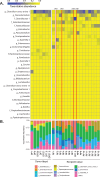Fecal Microbiota Transplantation in a Domestic Ferret Suffering from Chronic Diarrhea and Maldigestion-Fecal Microbiota and Clinical Outcome: A Case Report
- PMID: 38828210
- PMCID: PMC11143982
- DOI: 10.2147/VMRR.S449473
Fecal Microbiota Transplantation in a Domestic Ferret Suffering from Chronic Diarrhea and Maldigestion-Fecal Microbiota and Clinical Outcome: A Case Report
Abstract
This case report describes the effects of fecal microbiota transplantation (FMT) administered via enema in a 4-year-old spayed, champagne Domestic Ferret (Mustela putorius furo) with chronic diarrhea, maldigestion and weight loss. We aimed to establish a protocol for FMT as a novel therapeutic treatment for chronic diarrhea in domestic ferrets. We mapped the fecal microbiome by 16S rRNA gene amplicon sequencing to track the patient's fecal microbiota throughout the treatment and observation period. Initial oral FMTs were associated with temporary weight improvement but subsequent treatments, via enema and oral delivery, showed varied outcomes. Molecular analysis highlighted distinct gut microbiota composition profiles between the healthy donor and the diseased ferret. The diseased ferret initially exhibited high abundance of Enterobacteriaceae, Escherichia, and Enterobacter, which ultimately normalized to level like those found in the donor ferret. Overall, the gut microbiota of the recipient became more similar to the donor microbiota using a Yue-Clayton theta coefficients analysis. After a restoration of the gut microbiota and clinical improvement, the recipient's symptoms returned indicating that repeated FMTs might be required for long-term resolution of symptoms and complete restructuring of the gut microbiota. Future studies are warranted to map the microbiome of a larger population of domestic ferrets to investigate a potential correlation between fecal microbiota profiles and chronic/acute gastrointestinal disorders.
Keywords: FMT; exotic pets; fecal microbiota transplant; gut microbiome; microbiota restoration.
© 2024 Ravel and Hollifield.
Conflict of interest statement
The authors declare no conflicts of interest in this work.
Figures




Similar articles
-
Microbiome Responses to Fecal Microbiota Transplantation in Cats with Chronic Digestive Issues.Vet Sci. 2023 Sep 6;10(9):561. doi: 10.3390/vetsci10090561. Vet Sci. 2023. PMID: 37756083 Free PMC article.
-
Fecal microbiota transplants modulate the gut microbiome of a two-toed sloth (Choloepus didactylus).Zoo Biol. 2023 May-Jun;42(3):453-458. doi: 10.1002/zoo.21751. Epub 2023 Jan 11. Zoo Biol. 2023. PMID: 36629092
-
Microbiome Responses to Oral Fecal Microbiota Transplantation in a Cohort of Domestic Dogs.Vet Sci. 2024 Jan 19;11(1):42. doi: 10.3390/vetsci11010042. Vet Sci. 2024. PMID: 38275924 Free PMC article.
-
The role of the gut microbiome in colonization resistance and recurrent Clostridioides difficile infection.Therap Adv Gastroenterol. 2022 Nov 18;15:17562848221134396. doi: 10.1177/17562848221134396. eCollection 2022. Therap Adv Gastroenterol. 2022. PMID: 36425405 Free PMC article. Review.
-
Uses of Fecal Microbiota Transplantation in Neurodegenerative Disease: A Scoping Review.Cureus. 2024 Jun 12;16(6):e62265. doi: 10.7759/cureus.62265. eCollection 2024 Jun. Cureus. 2024. PMID: 39006586 Free PMC article.
References
-
- USFDA. Fecal Microbiota Products. Available from: https://www.fda.gov/vaccines-blood-biologics/fecal-microbiota-products. Accessed May 7, 2024.
-
- Garey KW, Dubberke ER, Guo A, et al. Effect of Fecal Microbiota, Live-Jslm (REBYOTA RBL) on health-related quality of life in patients with recurrent clostridioides difficile infection: results from the PUNCH CD3 clinical trial. Open Forum Infect Dis. 2023;10(8):ofad383. doi:10.1093/ofid/ofad383 - DOI - PMC - PubMed
Publication types
LinkOut - more resources
Full Text Sources

